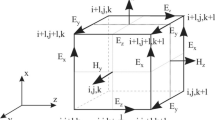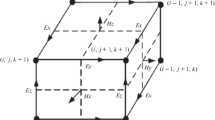Abstract
Adverse buried bodies near to ground surface would damage the buildings, and the detailed geometric characteristics of adverse buried bodies is essential for reducing damage and potential risk. To achieve this goal, forward simulation on geometric characteristics of three typical culverts in Chongqing were carried out in this paper. The response characteristics of (ground penetrating radar) GPR profiles caused by geometric characteristics and filling materials change were summarized, and the apexes of diffraction hyperbolas and lateral changes in the reflection pattern were used to determine the dimension and boundary of buried bodies. The comparison between GPR profiles interpretation result and the measured data in the field was used to verify the validity.
You have full access to this open access chapter, Download conference paper PDF
Similar content being viewed by others
Keywords
1 Introduction
With the evolution of long-term complex geological environment and the development of human activities, Natural geo-bodies and man-made buried bodies appear [1]. The demand for energy leads to the continuous development of land, and the existence of buried bodies will adversely affect the construction and operation of infrastructure and buildings.
GPR is a non-destructive geophysical detection technology. Because of its high detection accuracy, it is widely used in many fields [2]. Underground archaeological investigation is a typical representative [3]. For hydraulic engineering, the erosion inside the dam retaining walls, structurally hidden defects and groundwater distribution characteristics are all applied [4]. In the process of geological survey, it is used to locate buried geological bodies and survey near-surface faults [5], including detection of distribution characteristics of Karst caves and sinkholes, changes in rock and soil properties and water content [6]. In civil engineering, the drawing of internal cracks in rock slopes, the evaluation of the stability of existing buildings and road foundations, and the investigation of scour pits around underwater piers have achieved good results [7].
Through the above elaboration, it can be seen that the application of GPR in practical engineering is quite extensive, and has achieved fruitful research results and economic benefits. However, through the forwarding analysis of two-dimensional GPR images, the shape of the buried object, especially the size range, is relatively less defined. Therefore, forward simulation on geometric characteristics of three typical culverts in Chongqing were carried out in this paper. The response characteristics of (ground penetrating radar) GPR profiles caused by geometric characteristics and filling materials change were summarized, and the apexes of diffraction hyperbolas and lateral changes in the reflection pattern were used to determine the dimension and boundary of buried bodies. The comparison between GPR profiles interpretation result and the measured data in the field was used to verify the validity.
2 The Basic Principle of GPR
GPR is a geophysical method propagating through high frequency electromagnetic wave. A typical GPR system consists of a laptop, a DAD control unit, and an antenna. During the whole exploration process, the transmitted electromagnetic wave propagates in the medium. Due to the different properties of the medium, the interface between different materials is reflected. The reflected signal is received and used for image storage and processing.
3 Acquisition and Interpretation of GPR Image
3.1 GPR Image Acquisition
According to the size difference of buried body, 80 and 400 MHz antennas were employed to complete the continuous survey along the measurement line parallel to the road direction, and the supporting data was obtained using RIS software. To ensure the accuracy of the image acquisition, GresWin2 software is used to process the two-dimensional GPR image.
3.2 Interpretation of GPR Image
Figure 1a is the picture of culvert 1, and the stratum structure and engineering geological environment characteristics are shown in Fig. 1b.
Figure 2 is a two-dimensional GPR image of culvert section 1. There is a discontinuity in the two-dimensional image at a depth of 0.2 m, so that the existence of the interface L1 can be determined. The coaxial dislocation in the marked B and C regions in the figure indicates the damage on the actual structure (regions B and C in Fig. 1a). The diffraction hyperbola is formed at the top of the culvert (red curve in Fig. 2). Due to the presence of air between the culvert and the water flow, a diffraction independent of the top of the culvert is formed (green curve in Fig. 2). It can be seen from the diffraction curve vertex marking data that the buried depth is 1.24 m below the ground. Due to the high relative permittivity of water, the electromagnetic wave has a high degree of attenuation during propagation (region D in Fig. 2). In addition, due to the relatively developed vegetation on the surface of the bedrock, and the GPR image manifests the coaxial dislocation of the local area (Region A in Fig. 2).
The bedrock of culvert 2 is dense sandstone, and the shape of culvert is irregular quadrilateral. Through the actual investigation, the horizontal distance, buried depth and specific size from the starting point of the test point are shown in Fig. 3b. From the measured two-dimensional GPR image, the abnormal region E can be delineated (Fig. 4a). Through the processing of the image, the diffraction hyperbola will be formed at the inflection point of the irregular area, and the vertex of the hyperbola will be marked (Fig. 4b): F (1.8, 1.04), G (2.15, 1.04), H (1.75, 1.6), I (2.23, 1.6). By connecting these four points, the range of abnormal section can be determined.
Culvert 3 is a 0.35 m diameter concrete pipe buried 0.5 m below the soil level, surrounded by vegetation (Fig. 5a, b). Due to the difference in permittivity between air, concrete and rock and soil, the diffraction image appears black-white-black hyperbolic alternation. Ignoring the polarization and diffusion effects of the medium, the distance between the hyperbolic vertices in pairs represents the diameter of the concrete tube. According to the coordinates of the peak points L (1.2, 0.5) and M (1.2, 0.85), the buried body is buried 0.5 m deep, the diameter is 0.35 m, and the distance from the starting point of the measurement is 1.2 m. The position and size obtained by image analysis are consistent with the spatial position of the cross-section distribution. In addition, Fig. 6 shows an anomalous region K at a depth of 0.95 m, and the cross-sectional shape of the buried body is circular and the cross-sectional diameter is 0.24 m.
4 Conclusion
The shape of sections were corresponding to different diffraction images. An arcuate section appear a single diffraction hyperbolic. For an circle section, a pair of diffraction hyperbolas are formed at the top and bottom of the section. When the cross-section is an irregular quadrilateral, a diffraction single hyperbolic will be formed at the turning point of the irregular pattern.
Based on the vertex coordinates of the image diffraction curve and the change of the horizontal reflection image, geometric characteristics for the cross-section of buried bodies can be determined. The results indicate that the consistency of the regular graphic results is high, and there is a certain error for irregular quadrilateral, but the error value is only 2 mm.
Combing the measured data in the field with orthogonal two-dimensional GPR images is a future development direction from the perspective of engineering practice.
References
Zhang LF, Zeng XS, Yao Y, Liao WL (2007) Summary of karst collapse research in China. Chin J Geol Hazard Control 18(3):126–130
Deng SK, Qi MS (1993) Application of GPR in landslide and karst area detection. Earth Sci J Chin Univ Geosci 18(3):329–338
Orlando L (2013) GPR to constrain ERT data inversion in cavity searching: theoretical and practical applications in archeology. J Appl Geophys 89:35–47
Xu XX, Zeng QS, Li D, Wu J, Wu XG, Shen JY (2010) GPR detection of several common subsurface voids inside dikes and dams. Eng Geol 111:31–42
Pin WT, Chih CC, Tao TL et al (2015) Applying FDEM, ERT and GPR at a site with soil contamination. A case study. J Appl Geophys 121:21–30
Hossain D (2013) Evaluation of ground penetrating radar and resistivity profilings for 26 characterizing lithology and moisture content changes: a case study of the high-conductivity United Kingdom Triassic sandstones. J Geophys Eng 10:065003
Gutiérrez F, Galve JP, Lucha P, Bonachea J, Jordá L, Jordá R (2009) Investigation of a large collapse sinkhole affecting a multi-storey building by means of geophysics and the trenching technique (Zaragoza city, NE Spain). Environ Geol 58:1107–1122
Funding
The research on which this article is based has been supported by grants: The Independent innovation fund project (Tianjin University and Hainan University) (Grant No: TDHD-2206); Special Research Project of Guangzhou Metro Design and Research Institute Co; Ltd (Grant No: KY-2021-058); Hainan Provincial Natural Science Foundation of China (Grant No: 520QN229, 422RC599).
Author information
Authors and Affiliations
Corresponding author
Editor information
Editors and Affiliations
Rights and permissions
Open Access This chapter is licensed under the terms of the Creative Commons Attribution 4.0 International License (http://creativecommons.org/licenses/by/4.0/), which permits use, sharing, adaptation, distribution and reproduction in any medium or format, as long as you give appropriate credit to the original author(s) and the source, provide a link to the Creative Commons license and indicate if changes were made.
The images or other third party material in this chapter are included in the chapter's Creative Commons license, unless indicated otherwise in a credit line to the material. If material is not included in the chapter's Creative Commons license and your intended use is not permitted by statutory regulation or exceeds the permitted use, you will need to obtain permission directly from the copyright holder.
Copyright information
© 2023 The Author(s)
About this paper
Cite this paper
Li, H. et al. (2023). The Forward Simulation on Geometric Characteristics of Adverse Buried Bodies Using Ground Penetrating Radar. In: Wang, S., Li, J., Hu, K., Bao, X. (eds) Proceedings of the 2nd International Conference on Innovative Solutions in Hydropower Engineering and Civil Engineering. HECE 2022. Lecture Notes in Civil Engineering, vol 235. Springer, Singapore. https://doi.org/10.1007/978-981-99-1748-8_27
Download citation
DOI: https://doi.org/10.1007/978-981-99-1748-8_27
Published:
Publisher Name: Springer, Singapore
Print ISBN: 978-981-99-1747-1
Online ISBN: 978-981-99-1748-8
eBook Packages: EngineeringEngineering (R0)










